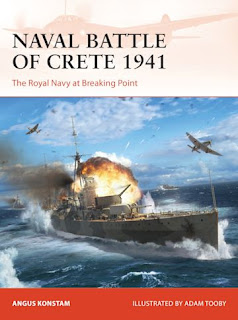This is a new book from Osprey in their campaign series by Angus Konstam that looks at the naval actions around the German attack on Crete in 1941. This is an unusual naval battle because there was very little ship v ship action. The heavy lifting was done by the Luftwaffe with some Italian support.
Very timely for me as I am just getting into Sam Mustafa's new WW2 naval game, Nimitz, although I have tackled air attacks yet.
The book follows the usual Campaign series format. A brief introduction and context, followed by the chronology. The Allies had evacuated from Greece, and the Germans planned a quick attack on Crete using Fallschirmjager, supplemented by a risky transport of troops by sea using an eclectic range of ships. The land battle is well covered by another Osprey Campaign book, Crete 1941. The Italian fleet had been defeated at Cape Matapan, so protecting the assault was going to be down to the Luftwaffe.
Then we get the opposing commanders to add some personalities to the story. Admiral Cunningham (or ABC as he was known), and his force commanders who are less well known. For the Axis, we have a famous name, General der Flieger Baron Wolfram von Richthofen, cousin of the WW1 ace.
Next come the opposing forces and their plans. The Royal Navy had just been reinforced and had four operational battleships, five light cruisers (no heavies) and 30 destroyers. However, they all had poor AA capability, which was not great as land-based and carrier air cover would be minimal. The Luftwaffe moved 716 combat aircraft to the region, including 180 fighters, 268 dive-bombers and 239 level bombers.
Cunningham formed four task forces to intercept any Italian Navy sortie and German transports. However, the lack of air cover meant those nearest to Crete mostly operated at night. During the day, the Luftwaffe concentrated around 150 Stuka's to attack the fleet. The Italians mostly attacked with level bombers, a tactic that rarely worked unless you were on board the unlucky destroyer, HMS Juno. Angus takes the reader through the different actions, which included successful interceptions of German transports. This added to the heavy casualties the Germans suffered during the invasion.
However, the Royal Navy also suffered heavy losses, and I was surprised by how often ships ran out of AA ammunition. So, I'll stop complaining about tedious ammo rules in wargames! HMS Gloucester was reduced to firing star shells and flares. The actions include the better-known detachment of Mountbatten and his five destroyers, which resulted in his ship, HMS Kelly, being sunk by a Stuka. The 'We Have Ways' podcast recently did an interesting episode on the Stuka.
Cunningham didn't bottle the need to cover the evacuation saying, 'it has always been the duty of the Navy to take the army overseas to battle, and if the army fail, to bring them back again. If we now break with that tradition, ever afterwards when soldiers go overseas they will tend to look over their shoulders instead of relying on the Navy. You have said, General [Wavell], that it will take three years to build a new fleet. I will tell you that it will take three hundred years to build a new tradition. If, gentlemen, you now order the army in Crete to surrender, the fleet will still go there to bring off the Marines.'
The Royal Navy lost three cruisers (Calcutta, Gloucester and Fiji) and six destroyers (Greyhound, Hereward, Imperial, Juno, Kandahar and Kelly), together with 1,828 men, while another 183 were wounded. Three battleships, an aircraft carrier, six cruisers and seven destroyers had also been damaged, some so severely that it would take several months or more before they were returned to service. They rescued 16,500 troops but wouldn't return to the Aegean in numbers for another three years. The Luftwaffe lost 284 aircraft, and another 125 damaged. 170 were Ju 52 transports. Not bloodless either with 311 air crew missing or killed.
Being an avid visitor of battlefields, I always look forward to 'The Battlefield Today' chapter. Obviously a sea battle doesn't have a site to visit, but there is plenty to see on Crete, which I did recently.
 |
| The Evacuation Memorial |
As you would expect, there is a great collection of maps, crucial to understanding naval battles, and some lovely artwork and plenty of pictures. Overall, this is excellent.

No comments:
Post a Comment